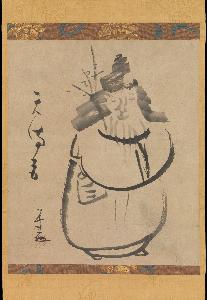Sengai Gibon
Sengai Gibon
Place: Nagata Near Yokohama
Born: 1750
Death: 1837
Biography:
Sengai Gibon, a Japanese monk of the Rinzai school of Zen Buddhism, was born in 1750 and passed away in 1837. He is renowned for his unconventional teachings, writings, and lighthearted sumi-e paintings. After spending half of his life in Nagata near Yokohama, he secluded himself in Shōfuku-ji in Fukuoka, the first Zen temple in Japan, where he spent the rest of his life.
Artistic Style and Philosophy
Sengai's paintings are characterized by their simplicity and expressiveness. He believed that art should be accessible to everyone, regardless of their understanding of Zen teachings. His most notable painting, "Maru-Sankaku-Shikaku", also known as "The Universe", features a circle, a square, and a triangle, which represent the universe, humanity, and enlightenment, respectively. Sengai's approach to art is reflected in his statement: "My play with brush and ink is not calligraphy nor painting; yet unknowing people mistakenly think: this is calligraphy, this is painting." This quote highlights his unique perspective on art, which blurs the lines between traditional categories.
Influence and Legacy
Sengai's influence can be seen in various aspects of Japanese art and culture. His emphasis on simplicity and accessibility has inspired many artists to explore new ways of expressing complex ideas through simple means. The Rinzai school of Zen Buddhism, to which Sengai belonged, is particularly known for its hard-to-understand teachings. However, Sengai's efforts to make these teachings more accessible have contributed to a broader understanding and appreciation of Zen philosophy. Some notable works by Sengai can be found at the Museum of Zen Buddhist Culture in Setagaya, Japan, and the New Orleans Museum of Art. These institutions showcase his unique style and provide insight into his artistic and philosophical contributions.
Notable Works and Artists
Some notable works by Sengai include:
- "Ink Drawing of Saigyō Looking at Mt. Fuji", which can be found at the Museum of Zen Buddhist Culture in Setagaya, Japan.
- "Tenmangū," Sugawara no Michizane as Tenjin Traveling to China, a painting that showcases his unique style and approach to sumi-e.
Other notable artists who have contributed to the Zen art movement include Hakuin Ekaku and Takuan Sōhō. Their works can be found on Hakuin Ekaku's Treasure Boat and Takuan Sōhō's biography. Key aspects of Sengai's art and philosophy include his emphasis on simplicity, accessibility, and the blurring of traditional categories. His legacy continues to inspire artists and philosophers alike, offering a unique perspective on the nature of reality and the role of art in expressing it. For more information on Sengai Gibon and his works, visit Sengai Gibon's page on Wikioo.org or his Wikipedia page.



